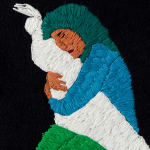-
Artworks
Aya Haidar British-Lebanese, b. 1985
Final Goodbye, 2024Embroidery on felt30 x 30 cm
11 3/4 x 11 3/4 in$ 6,000.00Further images
Exhibitions
Through the medium of embroidery, Haidar portrays scenes that convey the survivor stories recounted by women in refugee camps during her extensive engagement with displaced communities spanning over two decades. These pieces unfold narratives of loss, grief, resilience, and abuse, portraying these women as inadvertent protagonists thrust into the frontline of their own battles.
In the midst of relentless bombing and shelling in Gaza, this artwork captures the quiet strength of a woman. The scene freezes a moment when an aunt gently cradles her martyred child, silently protesting the injustice. The tranquillity portrayed resonates with the familiar calm we experience when putting our own children to sleep at night. The viewer is not only struck by the harrowing silence of this event but is also left with the lingering question: What was the unfortunate fate of the child's mother who isn't there to cradle her baby?
Literature
Through the medium of embroidery, Haidar portrays scenes that convey the survivor stories recounted by women in refugee camps during her extensive engagement with displaced communities spanning over two decades. These pieces unfold narratives of loss, grief, resilience, and abuse, portraying these women as inadvertent protagonists thrust into the frontline of their own battles.
In the midst of relentless bombing and shelling in Gaza, this artwork captures the quiet strength of a woman. The scene freezes a moment when an aunt gently cradles her martyred child, silently protesting the injustice. The tranquillity portrayed resonates with the familiar calm we experience when putting our own children to sleep at night. The viewer is not only struck by the harrowing silence of this event but is also left with the lingering question: What was the unfortunate fate of the child's mother who isn't there to cradle her baby?
1of 2







